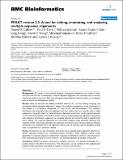PFAAT version 2.0 : A tool for editing, annotating, and analyzing multiple sequence alignments
Author(s)
Caffrey, Daniel R; Dana, Paul H; Mathur, Vidhya; Ocano, Marco; Hong, Eun-Jong; Wang, Yaoyu E; Somaroo, Shyamal; Caffrey, Brian E; Potluri, Shobha; Huang, Enoch S; ... Show more Show less
Download1471-2105-8-381.pdf (707.6Kb)
PUBLISHER_CC
Publisher with Creative Commons License
Creative Commons Attribution
Terms of use
Metadata
Show full item recordAbstract
Background: By virtue of their shared ancestry, homologous sequences are similar in their structure and function. Consequently, multiple sequence alignments are routinely used to identify trends that relate to function. This type of analysis is particularly productive when it is combined with structural and phylogenetic analysis. Results: Here we describe the release of PFAAT version 2.0, a tool for editing, analyzing, and annotating multiple sequence alignments. Support for multiple annotations is a key component of this release as it provides a framework for most of the new functionalities. The sequence annotations are accessible from the alignment and tree, where they are typically used to label sequences or hyperlink them to related databases. Sequence annotations can be created manually or extracted automatically from UniProt entries. Once a multiple sequence alignment is populated with sequence annotations, sequences can be easily selected and sorted through a sophisticated search dialog. The selected sequences can be further analyzed using statistical methods that explicitly model relationships between the sequence annotations and residue properties. Residue annotations are accessible from the alignment viewer and are typically used to designate binding sites or properties for a particular residue. Residue annotations are also searchable, and allow one to quickly select alignment columns for further sequence analysis, e.g. computing percent identities. Other features include: novel algorithms to compute sequence conservation, mapping conservation scores to a 3D structure in Jmol, displaying secondary structure elements, and sorting sequences by residue composition. Conclusion: PFAAT provides a framework whereby end-users can specify knowledge for a protein family in the form of annotation. The annotations can be combined with sophisticated analysis to test hypothesis that relate to sequence, structure and function.
Date issued
2007-10Department
Massachusetts Institute of Technology. Department of Electrical Engineering and Computer ScienceJournal
BMC bioinformatics
Publisher
BioMed Central Ltd
Citation
BMC Bioinformatics. 2007 Oct 11;8(1):381
Version: Final published version
ISSN
1471-2105